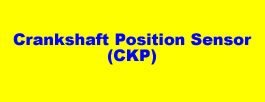Crankshaft Position Sensor
Crankshaft Position Sensor (CKP)
OPERATIONEngine speed is an important input to the Engine Management System (EMS). Crankshaft speed and position are the basis for many calculations made by the computer. Crankshaft position values are transmitted to the computer by pickup coils also known as Permanent Magnet (P/M) generators, Hall Effect sensors or optical sensors. The Crankshaft Position Sensor (CKP) also known as an engine speed sensor is typically located in close proximity to the crankshaft. In addition, the EMS uses the CKP sensor in conjunction with the camshaft position sensor to calculate and perform misfire diagnostics.
Crankshaft Position Sensor Symptoms
- A No Start / Intermittent Start condition – Can be caused by a faulty crankshaft position sensor due to loose connections, bad grounds, high resistance in the circuit, or opens in the circuit.
- Engine Misfire Diagnostic Trouble Codes
NOTE: Engine Mechanical conditions can also create the same or similar symptoms. (Don’t overlook basic mechanical integrity).
Crankshaft Position Sensor Learn Procedure
- The scan tool monitors certain component signals to determine if all conditions are met to continue with the procedure. The scan tool only displays the condition that inhibits the procedure while monitoring the following components:
- CKP sensors activity-If there is a CKP sensor condition, refer to the applicable DTC that was set.
- Camshaft position (CMP) sensor activity-If there is a CMP sensor condition, refer to the applicable DTC that was set.
- Engine coolant temperature (ECT)-If the ECT is not warm enough, idle the engine until the ECT reaches normal operating temperature.
NOTE: For additional diagnostic information, refer to DTC P1336.
- Install a scan tool.
- Monitor the powertrain control module for DTCs. If other DTCs are set, except DTC P1336, refer to the Diagnostic Trouble Code (DTC) List for the applicable DTC that was set.
- Select the crankshaft position (CKP) variation learn procedure.
- Observe the fuel cut-off.
- The scan tool instructs you to perform the following:
- Block the drive wheels.
- Apply the vehicles parking brake.
- Cycle the ignition from OFF to ON.
- Maintain pressure on the brake pedal.
- Start and idle the engine.
- Place the vehicles transmission in Park (A/T) or Neutral (M/T).
- With the scan tool, enable the CKP system variation learn procedure.
- Slowly increase the engine speed to the RPM that you observed. IMPORTANT: While the learn procedure is in progress, release the throttle immediately when the engine starts to decelerate. The engine control is returned to the operator and the engine responds to throttle position after the learn procedure is complete.
- Immediately release the throttle when fuel cut-off is reached.
- The scan tool displays Learn Status: Learned this ignition. If the scan tool does not display this message and no additional DTCs set, refer to Symptoms - Engine. If a DTC set, refer to Diagnostic Trouble Code (DTC) List for the applicable DTC that set.
- Turn OFF the ignition for 30 seconds after the learn procedure is completed successfully.
Crankshaft Position Sensor Replacement
Removal & InstallationTo Remove:
- Disconnect the battery ground cable.
- Disconnect the electrical connector.
- Remove the mounting bolts
- Remove the sensor.
To Install:
- Install the sensor.
- Install the mounting bolts
- Connect the electrical connector.
- Connect the battery ground cable.

Car Engine Sensor List
- Powertrain Control Module (PCM)
- Throttle Position (TP) sensor
- Mass Air Flow (MAF) sensor
- Intake Air Temperature (IAT) sensor
- Idle Air Control (IAC) valve
- Engine Coolant Temperature (ECT)
- Heated Oxygen Sensor (HO2S)
- Camshaft Position (CMP) sensor
- Knock Sensor (KS)
- Vehicle Speed Sensor (VSS)
- Crankshaft Position (CKP) sensor
- Engine Trouble Codes


